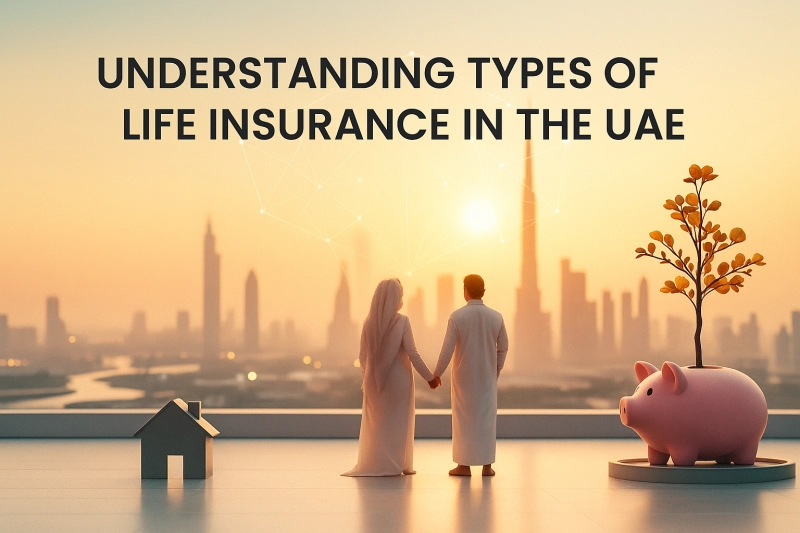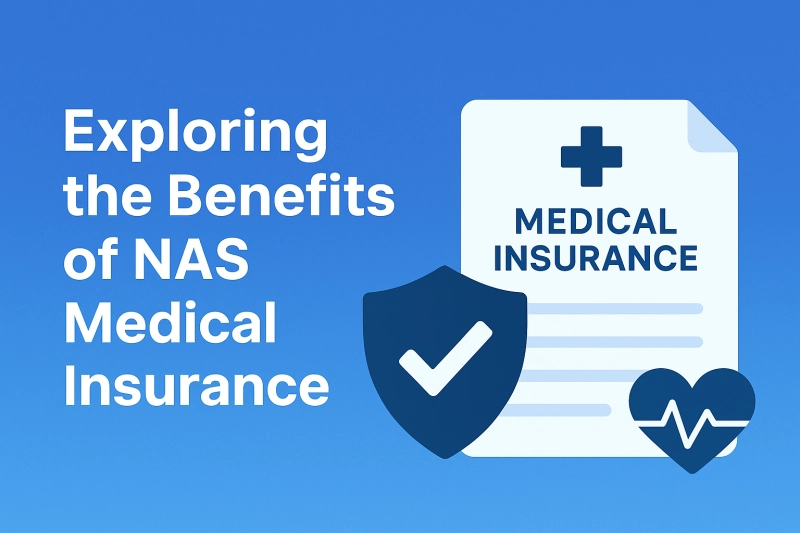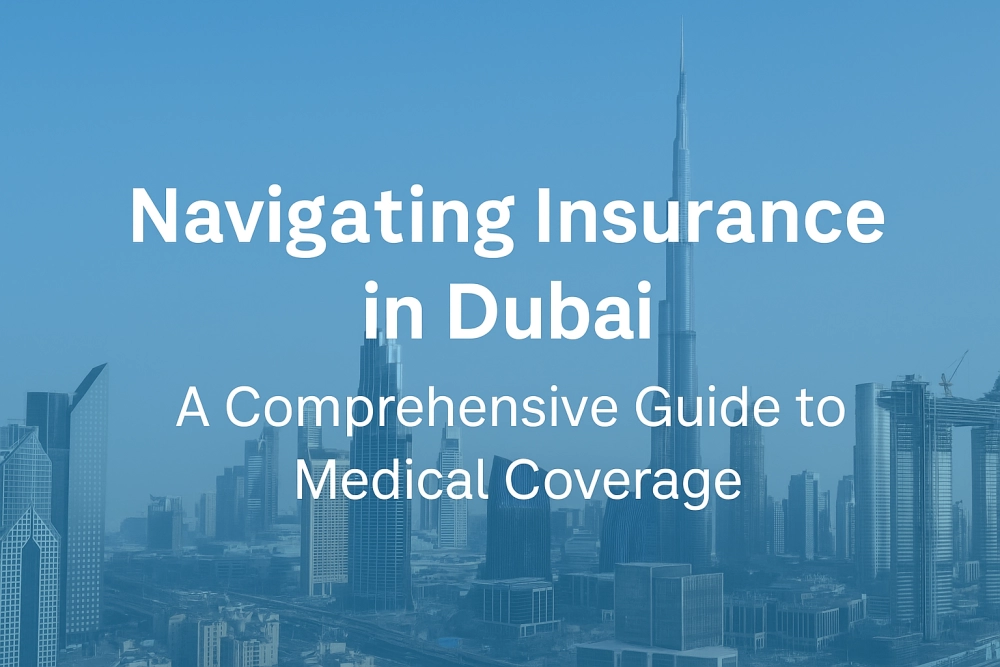At its core, life insurance is a simple promise you make to your family: to make sure they're financially protected even if you're not around anymore. It might seem complicated, but all the different options really boil down to two main categories: Term Life, which gives you coverage for a specific period, and Permanent Life, which is designed to last your entire lifetime.
Getting to grips with that one difference is the first, most important step you can take towards securing your family's future.
Why Life Insurance Is Your Financial Safety Net
Think of it like a financial safety net stretched out beneath your loved ones. Here in the UAE, our financial responsibilities can often be quite significant. This net is what ensures an unexpected tragedy doesn't turn into a financial catastrophe for the people who rely on you most.
But its purpose runs much deeper than just a single payout. The right policy acts as a powerful shield, protecting your family from the weight of major debts and financial burdens.
This could mean:
- Paying off the mortgage, so your family can stay in their home without worrying about the monthly payments.
- Funding your children's education, keeping their future dreams and opportunities alive and well.
- Replacing your income, which gives your spouse and kids the stability they need to carry on without a drastic change in their quality of life.
More Than Just Protection
Some life insurance policies go a step further. Beyond just providing a death benefit, they can also work as a long-term savings or investment vehicle. This dual purpose is a big reason why life insurance has become such a cornerstone of financial planning in the UAE.
This guide is here to demystify all the options on the table, helping you figure out which type of policy is the right fit for your life. Making these choices is probably easier than you think, but it's always smart to understand the fundamentals first. In fact, there are a few key things you must know about buying life insurance before you even start looking.
Life Insurance at a Glance
To make things clearer, let's quickly compare the main types of life insurance. This table breaks down the essentials so you can see the core differences at a single glance.
| Insurance Type | Coverage Period | Primary Purpose | Cash Value Component |
| Term Life | Fixed period (e.g., 10, 20, 30 years) | Affordable, pure protection for a specific time | No |
| Whole Life | Lifelong | Lifelong protection and guaranteed cash value growth | Yes, guaranteed growth |
| Universal Life | Lifelong | Flexible premiums and death benefit; cash value grows based on interest rates | Yes, flexible/variable growth |
As you can see, the right choice really depends on what you're trying to achieve—whether it's pure protection for a set number of years or a lifelong policy that also builds wealth.
Securing Your Future Goals
Ultimately, the entire point is to find a solution that gives you complete peace of mind. It’s a foundational piece of any solid financial plan, especially for ensuring financial security in retirement and for your family's long-term well-being.
As we go through this guide, we'll break everything down into simple, practical terms. And remember, platforms like InsuranceHub.ae are here to help you compare your options and find a plan that lines up perfectly with your family's unique needs and goals.
Term Life Insurance: The Power of Simplicity
When you boil it all down, term life insurance is the most straightforward option on the table. Think of it like renting financial protection for a specific time in your life. You choose how long you need the cover for—this is the ‘term’—pay a set premium, and if you were to pass away during that period, your family receives a tax-free lump sum.
It’s designed to do one job and do it well: replace your income and cover those big, but temporary, financial responsibilities.
This pure, uncomplicated approach makes it a hugely popular and affordable choice. For many expats in the UAE, life has clear financial timelines—think paying off a 25-year mortgage or funding your children's education until they turn 18. Term life insurance lines up perfectly with these specific goals, giving you a massive amount of coverage without the higher price tag of a lifelong policy.
Level Term vs. Decreasing Term
Digging a little deeper, you'll find two main variations, each built for a different purpose:
- Level Term: With a level term policy, both your monthly premium and your final payout amount are locked in and stay the same for the entire term. If you take out a AED 2 million policy for 20 years, your family gets AED 2 million whether you pass away in year one or year nineteen. It's predictable, which makes it perfect for replacing a steady income.
- Decreasing Term: This one is a bit different. Here, the payout amount gradually reduces over the life of the policy, usually designed to mirror a large debt like a mortgage. As you chip away at your home loan, your coverage amount shrinks alongside it. This makes the premiums even more affordable, as it’s a specialised tool to make sure one specific debt gets cleared.
The infographic below shows how people typically match their term length to their major life events and financial responsibilities.
As you can see, these policies are structured to create a protective shield during the years when your financial obligations are at their peak.
Weighing the Pros and Cons
Just like any financial product, term life insurance isn't a one-size-fits-all solution. It has clear strengths and weaknesses, and it's vital to understand both to see if it’s the right fit for your life here in the UAE.
"Term life insurance offers the largest amount of coverage for the lowest initial cost. It’s pure protection, designed to give your family maximum support during your most critical financial years without complicating matters with investment components."
This focus on pure protection is its greatest advantage. It’s simple to understand, easy to budget for, and provides a substantial safety net when your family would need it most.
However, its temporary nature is also its main drawback. Once the term is up, your coverage simply ends. If you outlive the policy, there’s no payout, and it doesn't build up any cash value or savings over time. For anyone looking for lifelong security or a policy that doubles as a savings vehicle, other types of life insurance might be a better match.
Whole Life Insurance: Protection That Lasts a Lifetime
If you think of term life insurance as ‘renting’ your protection, then whole life insurance is the equivalent of ‘owning’ it. This is a type of permanent life insurance, and the name says it all—it’s built to cover you for your entire life, not just a specific chapter. As long as you keep up with the premiums, your beneficiaries are guaranteed to receive the death benefit.
But that’s not the whole story. Whole life does more than just offer a lifelong safety net. With every premium you pay, a portion is funnelled into a built-in savings vehicle known as cash value. This little nest egg grows over time at a guaranteed, tax-deferred rate, slowly transforming your policy into a financial asset you can actually use while you’re still around.
This dual-purpose design is what really sets it apart. It’s not just about protecting your family’s future; it's also a disciplined approach to building your own wealth.
How Cash Value Works for You
The cash value component is really the engine driving a whole life policy. It unlocks some powerful financial flexibility, which can be a game-changer for UAE residents with long-term plans.
Here are a few ways you can typically tap into it:
- Borrow against it: You can take out a loan using your cash value as collateral, often at a pretty competitive interest rate.
- Make a withdrawal: Need some cash? You can simply withdraw a portion of your cash value directly.
- Surrender the policy: If a serious financial emergency hits, you have the option to surrender the policy and walk away with the accumulated cash value.
This accessibility makes whole life a robust tool for much more than just protection. It can become a source of supplemental retirement income, help fund a major life event, or simply act as a financial cushion when you need it most.
"Whole life insurance offers a unique combination of lifelong protection and predictable, guaranteed growth. It’s built for individuals who see insurance not just as a defensive tool, but as a proactive part of their long-term estate and legacy planning."
Of course, these powerful benefits come at a price. The main drawback you’ll hear about whole life is that its premiums are significantly higher than term life. The principles for setting these premiums are rooted in a long history—in fact, the first mortality tables were developed way back in 1693, a crucial step that made life insurance a predictable financial product.
Is Whole Life a Good Fit for You in the UAE?
Deciding if this is the right policy for you really boils down to your long-term financial picture. It's an excellent choice for anyone focused on building a legacy, estate planning, or simply making sure funds are available to cover final expenses and any inheritance taxes, no matter when they pass away.
It provides a level of certainty in an uncertain world. However, if your main goal is getting the maximum amount of coverage for a specific period at the lowest possible cost, then term life is likely the better fit. For business owners, there are also specialised policies, and you can explore more about the benefits of group life insurance for your employees.
At the end of the day, whole life insurance is for those who value permanence and predictability and are willing to invest more for that lifelong peace of mind.
Universal Life Insurance: Flexible Coverage for Changing Needs
If whole life insurance is the steady, predictable bedrock of permanent coverage, think of Universal Life (UL) insurance as its adaptable, dynamic counterpart. It’s a financial shield built to bend and flex as your life unfolds, making it one of the most customisable forms of life insurance out there.
The magic of a UL policy is the control it hands back to you. It lets you adjust your premium payments—and in some cases, even the death benefit—to match your current financial reality. Had a fantastic year at work? You can pay more into your policy to supercharge its cash value growth. Facing a tight month? It’s often possible to reduce your premium for a while.
How Flexibility Powers Your Policy
This adaptability is what makes Universal Life a compelling choice for financially savvy people in the UAE who want more hands-on control. The policy works by unbundling its three core parts: the insurance cost (what it takes to cover the death benefit), policy administration fees, and the cash value account.
When you pay your premium, the money first covers the insurance costs and fees. Whatever is left over gets channelled into your cash value account, where it earns interest tied to current market rates. This is where it really differs from whole life, which offers a more predictable, guaranteed rate of return.
"Universal Life insurance is crafted for individuals whose income and financial obligations aren't set in stone. It delivers lifelong protection but with the power to modify payments and benefits, making it a dynamic tool for long-term financial security."
This unique structure gives you some powerful options:
- Pay more than the minimum: Doing this builds up your cash value faster, accelerating its growth potential.
- Pay less or even skip a payment: If you’ve built up enough cash value, you can use those funds to cover the policy's costs, keeping your coverage active during leaner periods.
Understanding the Risks and Rewards
The biggest draw of a Universal Life policy is, without a doubt, its flexibility. It can adjust to your financial ups and downs without forcing you to cancel your coverage entirely. The potential for higher returns on your cash value when interest rates are favourable is another major plus.
However, with great flexibility comes a bit more complexity and risk. Because the cash value growth isn't guaranteed and is linked to fluctuating interest rates, it can be unpredictable. If rates dip, your cash value might grow slower than you'd hoped, which could mean you'll need to pay higher premiums later to prevent the policy from lapsing. It’s a crucial trade-off you need to be comfortable with.
For many, having this level of control over a financial product is a huge advantage. It's the same reason businesses often look for specific plans to meet diverse employee needs, like tailored group private medical insurance in Abu Dhabi. For the right person, a UL policy offers a powerful combination of permanent protection and financial agility that's hard to beat.
How to Choose Your Life Insurance Policy
We’ve walked through the main types of life insurance, but now comes the big question: which one is right for you? Picking a policy isn’t about finding the “best” product on the market. It’s about finding the one that fits your unique financial picture and life goals, right here in the UAE.
Think of it like a personal financial health check. The first step is to take an honest, clear-eyed look at your current situation and your responsibilities down the road. Forget generic advice—the perfect policy for your neighbour probably isn't the one for you. This is all about custom-fitting the protection to your life.
Your Personal Financial Audit
To get started, you need a firm grasp of what, exactly, you’re protecting. This means figuring out the financial gap your family would face if your income suddenly vanished. A good policy needs to be big enough to cover these obligations without causing more financial stress.
Here’s a simple checklist to get your thoughts organised:
- Your Debts: Add up every loan you have. We’re talking about your mortgage, car loans, credit card balances, and any other personal debts.
- Your Dependents' Needs: How much money would your family need to keep their current standard of living? Think about daily expenses, rent, utilities, and all the future costs.
- Your Long-Term Ambitions: What are your biggest goals for the future? This usually includes things like funding your children’s university education or making sure your spouse has a comfortable retirement.
Answering these questions gives you a real number to aim for. You’ll go from a vague idea of "needing insurance" to a clear understanding of the exact coverage you require.
"The most effective life insurance policy is one that is meticulously matched to your liabilities and your family’s future needs. It’s a personalised solution, not an off-the-shelf product."
Comparing Your Options in the UAE
Once you have your number, it's time to find a policy that delivers that protection at a price you can manage. This is where comparing quotes is absolutely essential. Using a platform like InsuranceHub.ae lets you see different plans side-by-side, making it much easier to weigh the costs and benefits of each.
To make a smart choice, you really need to understand the difference between term and permanent life insurance and how that decision shapes your long-term plan. Beyond the policy type, you should also look into an insurer's reliability. A great way to get a feel for this is by understanding the claim settlement ratio of different providers.
This focus on tailored protection is clearly reflected in market trends. The insurance penetration rate in the UAE has been rising steadily, driven by economic growth and government initiatives encouraging residents to lock in their financial security. This growth shows a collective shift towards recognising how vital thoughtful financial planning is. By taking the time to assess your needs and compare your options, you’re joining a growing number of residents making smart choices to protect their loved ones.







